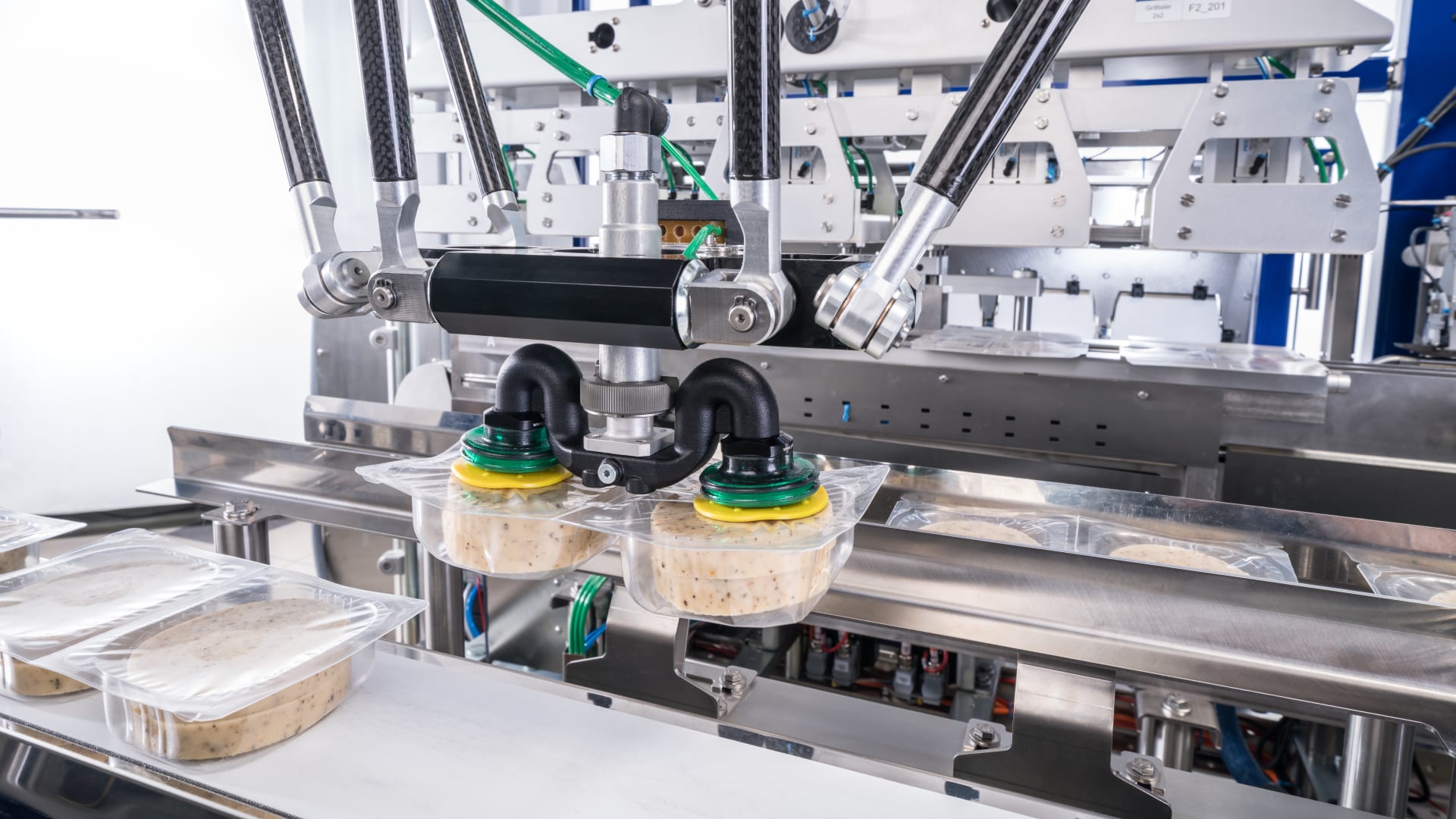ROBOT TECHNOLOGY FOR FLAWLESS PACKAGING
- An efficient, high-precision packaging solution
- Hand-like tool for reliable fixing
- Packaging steps decoupled for process reliability
REQUIREMENTS
The sleeve is neatly applied to barbecue cheese packs
The long-established Saxony-based Heinrichsthaler dairy provides cheese specialities to suit all tastes – and for some time now it has also been offering several varieties of oven cheese and barbecue cheese rounds. In the past, the packaging of the barbecue rounds caused a great deal of dissatisfaction, as the sleeves used to wrap the barbecue rounds, which were packed in thermoformed trays, were often not neatly attached using conventional linear packaging technology. Schubert therefore developed a compact, efficient and very precise cartoner that now reliably solves this problem. The solution involves the decoupling of individual packaging steps, a special hand-like format tool and robot technology that enables precise packaging with previously generated breaking edges.
The fact that the French Camembert soft mould cheese found its way to Germany is most likely thanks to Heinrichsthaler Milchwerke GmbH from the town of the same name near Radeberg. Since 1884, the well-known German cheese producer has been making this cheese speciality as well as several more common varieties such as Edam, Gouda or Tilsit. For all those who enjoy eating cheese warm, the portfolio includes various types of oven cheese and barbecue rounds. Regional ties to suppliers, some of which have existed for generations, short transport routes as well as cost-effective and sustainable production and packaging processes are extremely important to the quality manufacturer. However, the previous packaging solution for the Grilltaler barbecue rounds didn’t meet these requirements. It is important to know that when buying a pack of barbecue rounds, the consumer receives a total of two or four patties in a thermoformed tray made of soft plastic – shrink-wrapped either individually or in twos. Around the thermoformed pack is a sleeve made of cardboard on which product details are printed. The problem with the linear solution was that the soft contours of the thermoformed trays made it almost impossible to fold the sleeves over cleanly without first creating broken edges.
SOLUTION
Decoupled packaging steps for greater process reliability
With the cartoner Schubert developed for the dairy, this problem is history. The compact system wraps the Grilltaler packs efficiently and cleanly with a cardboard sleeve. The space-saving cartoner’s outstanding process reliability was integrated into the design right from the start: Instead of continuously packing the products in a line as before, the packing step is now decoupled. Robots pre-group the barbecue cheese rounds, pick them up and pack them into the sleeves using a hand-like tool specially developed by Schubert. Another special feature of the new packaging solution is that the sleeves are already broken at the edges during the packaging process. The system is so flexible that Heinrichsthaler will be able to use it to pack new formats just as precisely and cleanly in the future. This integration of the various transport and robot systems ensures that the machine is an extremely future-proof and performance-oriented investment.
Our products are very dear to us. We are delighted that they are now given the look they deserve thanks to perfectly tailored packaging.
UWE LAMMECK
CEO AND MANAGING DIRECTOR AT HEINRICHSTHALER, APRIL 2022
TECHNICAL DETAILS
- Compact cartoner in a frame
- 70 to 90 packs per minute
- Breaking edges for clean packaging
- Specially developed tool
Processes that work together seamlessly
At the beginning of the packaging process, the thermoformed trays, already filled with the barbecue cheese rounds, enter the machine on a conveyor. A T3 robot then places the products alternately onto two vacuum conveyors to the left and right of the product belt. The vacuum conveyors move the barbecue cheese packs to the sleeve wrapping position. At the same time, an F3 robot in the first station takes five sleeve blanks at a time from the magazine and feeds them to an F2 robot, which draws them in from above and places them onto the line’s third vacuum conveyor. Once placed onto the vacuum conveyor, the robot tool presses down slightly on the sides of the sleeves to create breaking edges. The best-before date is also printed onto the packaging in this step. The vacuum conveyor with the blanks then moves to the sleeving position. An F2 robot equipped with the specially developed tool takes five blanks at a time from the vacuum conveyor, folds them, picks up the barbecue cheese rounds from above and wraps them with the pre-glued sleeves in a single step. The technically advanced tool resembles a hand with the sleeve in its palm and seals the product with the sleeve in mid-air, so to speak.
Breaking edges: the solution for clean packaging
Unlike its predecessor, the new Schubert line at Heinrichsthaler works with robot technology. This allows the edges of the sleeves to be broken during the packaging process so that they can then be flawlessly wrapped around the thermoformed trays. The clocking also enables continuous and trouble-free operation. With the new Schubert line, Heinrichsthaler can currently package between 70 and 90 Grilltaler barbecue round packs per minute. In the future, new thermoformed tray formats with different heights or basic dimensions can also be processed with very little effort.

A T3 robot transfers the barbecue rounds into two vacuum conveyors to the right and left of the conveyor.

A special tool processes five blanks simultaneously and wraps the barbecue cheese rounds with the sleeves.







